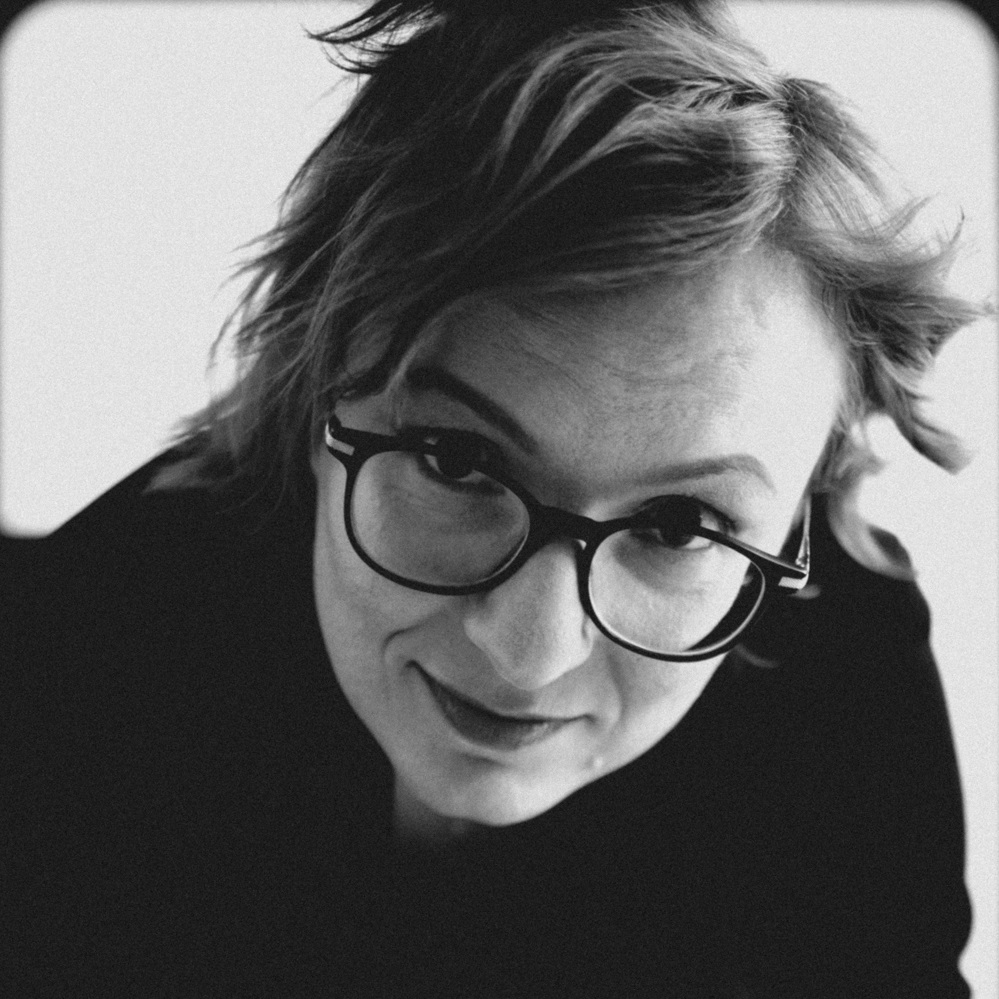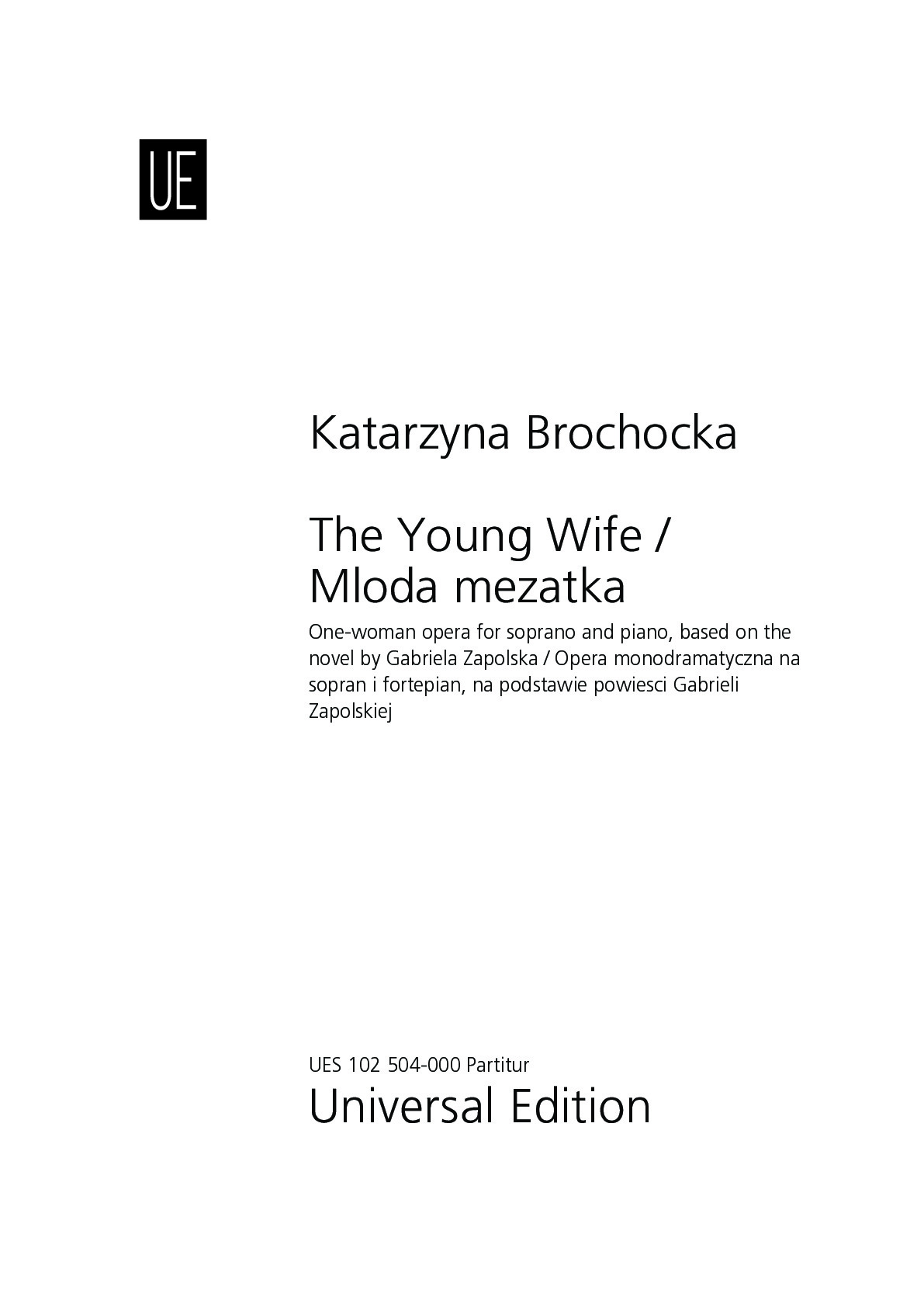

Katarzyna Brochocka
The Young Wife / Młoda mężatka
Duration: 60'
Dichter der Textvorlage: Gabriela Zapolska
Libretto: Katarzyna Brochocka
Solos:
soprano
Roles:
Young Wife / Młoda mężatka
The Young Wife / Młoda mężatka
Printed/Digital
Translation, reprints and more

Katarzyna Brochocka
Die Junge EhefrauType: Dirigierpartitur
Language: Englisch (Großbritannien)
Sample pages
Video
Work introduction
The Young Wife is an intimate and expressive story told by a freshly married woman trapped in a loveless marriage, who finally finds her happiness. The marriage had been arranged by her parents, who sent her off with a sizeable dowry. She didn't have a chance to get to know her husband at all before the wedding and now she slowly discovers all his drawbacks, including his barely-hidden dislike of her. The opera consists of the Overture and seventeen arias (diary entries) intertwined with sixteen piano interludes marking the passing of time. The soprano plays the role of the title heroine, as well as some other characters: Julian (her husband); Iza (or Lisa in the English version) - Julian's lover; Adam (Young Wife's true love). Opera is joyful and full of contrasts. The composition was first recognized in London (Opera up Close - competition) and awarded in Washington (2013 Capital Fringe Festival Award for the best opera & music theater). Its English version was performed in Washington, Baltimore, London, and Warsaw. The CD recording of the Polish version was published in 2020 by CD Accord Edition.
The libretto was adapted from the semi-autobiographical novel by Gabriela Zapolska (1857-1921) a Polish novelist, playwright, theater critic, and stage actress. Zapolska has received the most recognition for her sociosatirical comedies. Her stage plays have been translated into many foreign languages and performed at Polish and European theaters, as well as adapted for radio and film. The Memoirs of a Young Wife was the last published work by Zapolska.
Interludes from Katarzyna Brochocka's opera The Young Wife can be performed as a separate piano cycle.
Reviews:
Brochocka drew the libretto from Gabriela Zapolska's 1901 novella The Memoirs of a Young Wife, shaping it into a series of diary entries, sometimes gently amusing but often heartbreakingly sad, as the heroine recounts her infatuation with another man. The piano writing is dense, febrile, and often panic-stricken – a musical representation of the 20-year-old's increasing realization that she is in a loveless marriage.
Stephen Pritchard, Dido and Aeneas/Young Wife, "The Observer", 2014
Young Wife is impressive. It’s a continuous monologue from a woman disappointed with married life. A Madame Bovary-esque sense of disenchantment bristles through her arias – at times sharp and aggressive, at others soothing and contemplative. The opera feels more like a duet between voice and piano, with atmospheric interludes from the latter to show time passing. It feels relentless at times, and the hour drags, but it’s a good illustration of women’s incessant internal chatter. And what a pleasure to hear an opera that was specifically composed for this intimate environment.
Francesca Wickers, Review: Young Wife / Dido and Aeneas, OperaUpClose, FringeOpera.com
The vocal lines won’t win over haters of modern opera — lots of tonally ambiguous bits with shocking high leaps for effect. But screw me if they don’t occasionally rise above the workaday and work some emotional magic. Charlie Eccleshare, Dido and Aeneas/Young Wife/OperaUpClose, King’s Head – opera review, Evening Standard
Brochocka hopes the piece has relevance to a modern audience. Musically, at least, the composer has combined classical forms and dances with discordant modernism. Structured as an ongoing monologue, the music is more akin to a lengthy recitative than a traditional aria, the music changing with each new diary entry and change of mood from distracted pointillism to dreamlike reverie and excited melisma. As such, with few obvious melodic themes, the music flows like a stream of consciousness, albeit with lengthy transitions between each diary entry that represent the passing of time with relentless chromaticism.
Ed Nightingale: Young Wife / Dido & Aeneas - OperaUpClose @ The Kings Head Theatre, The Gizzle Review
The music (in a spiky style somewhere between Scriabin and Stravinsky) switches from comedy to tragedy in a gulp, the vocal writing is assured and there are some atmospheric interludes.
Warwick Thompson, Young Wife/Dido & Aeneas at King’s Head Theatre, Metro
What is necessary to perform this work?
The libretto is in Polish and English. The language is to be selected for performance.
The opera is written for one singer (soprano) and one pianist. The singer performs a few roles:
1, The Young Wife - title heroine,
2, her husband (Julian),
3, his lover (Ms. Troicka),
4, Young Wife's true love - Mr. Adam.
The Full Score contains the soprano part and the piano part.
The range for soprano singing voice is: des1 - e4 / [from d flat 4 to e8 ]
- the lowest notes are h, c1 / [b3, c4] - that is a sprechgesäng
- the very high notes are in a few arias:
c4 [c8] - 4th Aria / December 19th
d4 [d8] - 1st Aria / October 22nd
e4 [e8] (alternative h3 [b7]) - 8th aria / April 28th
Listen to those arias and see if that fits your voice.
[Polish] / Informacje dotyczące rozpiętości dźwięków dla głosu sopranowego:
cała partia sopranowa w operze mieści się pomiędzy: des1 - e4
- najniższe tony to b, c1 / - to dźwięki w technice sprechgesäng
- bardzo wysokie nuty występują w niektórych ariach:
c4 - aria czwarta / 19 grudnia
d4 - aria pierwsza / 22 października
e4 [e8] (alternatywa h3 [b7]) - aria ósma / 28 kwietnia
Posłuchaj, proszę tych arii i zobacz, czy wysokości dźwięków pasują do Twojego głosu.
